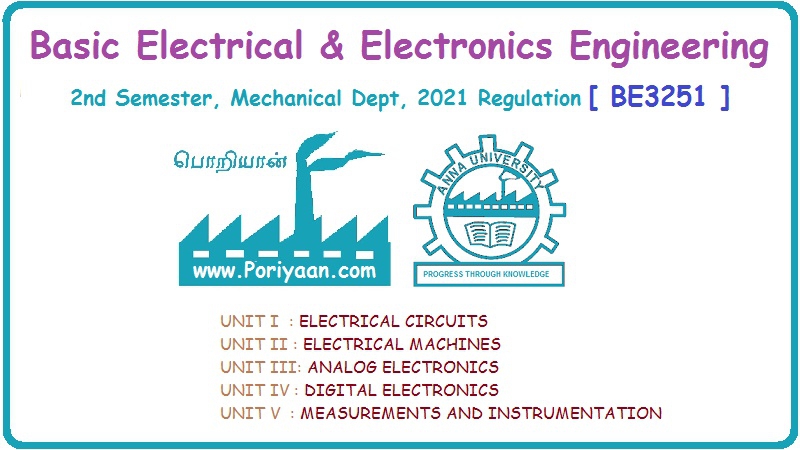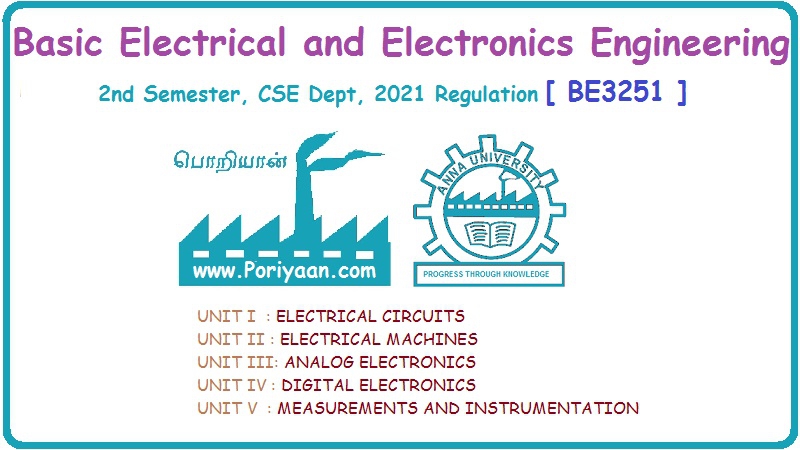Basic Electrical and Electronics Engineering: Unit II: Electrical Machines
Principle of Operation for DC Generator
Let us consider a single turn rectangular coil ABCD rotating about its own axis in a magnetic filed provided by either permanent magnet or electromagnets.
PRINCIPLE
OF OPERATION
Let
us consider a single turn rectangular coil ABCD rotating about its own axis
(Fig.2.6) in a magnetic filed provided by either permanent magnet or
electromagnets. The two ends of the coil are joined by two slip rings 'a' and
'b' which are insulated from each other and from the central shaft. Two collecting
brushes made up of carbon or copper press against the slip-rings. Their
function is to collect the current induced in the coil and to convey it to the
external load resistance R. The rotating coil is called as armature and the
magnetic as field magnets.
Assume
the coil is rotated in an anti clock wise direction.
Let
'l' is the length and 'b' is the breadth of the coil in meters. When the coil
sides AB and CD are moving parallel to the magnetic field, the flux lines are
not cut and no emf is induced in the coil. At this position assume angle of
rotation 'Ɵ' as zero.
This
vertical position of the coil is the starting position. According to faraday's
law, the emf induced is proportional to the rate of change of flux linkages.
Where
e
= - N dϕ/dt …………(1)
N
- number of turns
Φ
- flux
t
- time
If
N = 1,
e
= - dϕ/dt
Initially,
the coil is moving parallel to the flux lines, no flux line is cut. So
dϕ/dt
= 0, and e = 0
After
't' seconds, the coil have rotated through an angle 'ωt' radians in the
anticlockwise direction. The flux linking with the coil is
B
l b cos ωt.
e
= - d/dt (B l b cos ωt)
=
- B l b ω( - sin ωt) = B l b ωsin ωt
e
= Em sin ωt ……....(2)
Where
Em
= B l b ω
Em
= maximum value of induced emf
When
Ɵ = 90°, the coil sides are moving at right angles to the flux lines. The flux
lines
are cut at the maximum rate and the emf induced is maximum.
When
Ɵ = 180°, the coil sides are moving parallel to flux lines (AB and CD have
exchanges positions) and the emf induced is zero.
When
Ɵ = 270°, the coil sides again move at right angles to the flux lines but their
position reversed. The induced emf is maximum in the opposite directs.
When
Ɵ = 360°, the coil sides again move parallel to the magnetic field and the emf
induced is zero. The coil has now come back to the starting point.
If
the rotation of the coil is continued the changes in the emf are again
repeated. The changes in voltage 'e', with respect to the angle 'Ɵ' can be
plotted as shown in fig.2.7.
The
emf changes from instant to instant and becomes alternatively positive and
negative. This emf is called as an alternating emf.
The
induced emf in the coil can be increased by
i)
Increasing the flux density (B)
ii)
Increasing the angular velocity (ω)
In
commercial generators a large number of coils are used and they are housed in
the armature.
The
current flowing in the external resistance to a DC generator is made
unidirectional by replacing the slip rings by a split rings as shown in fig
2.8.
The
ring is split into two equal segments P and Q and the segments are insulated
from each other and also from the shaft.
The
coil side AB is always attached to the segment P and CD to Q. It is shown in
fig.2.9. The brushes B1 and B2 touch these segments and
to collect the current. During the first half revolution, current flows along
ABLMCD through brush B1(Positive) and into B2 (Negative).
After
half a cycle AB and CD have exchanged positions along with the segments P and Q
and current flows through DCLMBA. B1 is in contact with for each half revolution
the positions of segments P and Q also reverse shown in fig.2.10.
The
current in the load is always unidirectional is shown in fig.3.11.
In
a generator, the split rings are called commutator.
Basic Electrical and Electronics Engineering: Unit II: Electrical Machines : Tag: : - Principle of Operation for DC Generator
Related Topics
Related Subjects
Basic Electrical and Electronics Engineering
BE3251 2nd semester Mechanical Dept | 2021 Regulation | 2nd Semester Mechanical Dept 2021 Regulation
Basic Electrical and Electronics Engineering
BE3251 2nd Semester CSE Dept 2021 | Regulation | 2nd Semester CSE Dept 2021 Regulation

